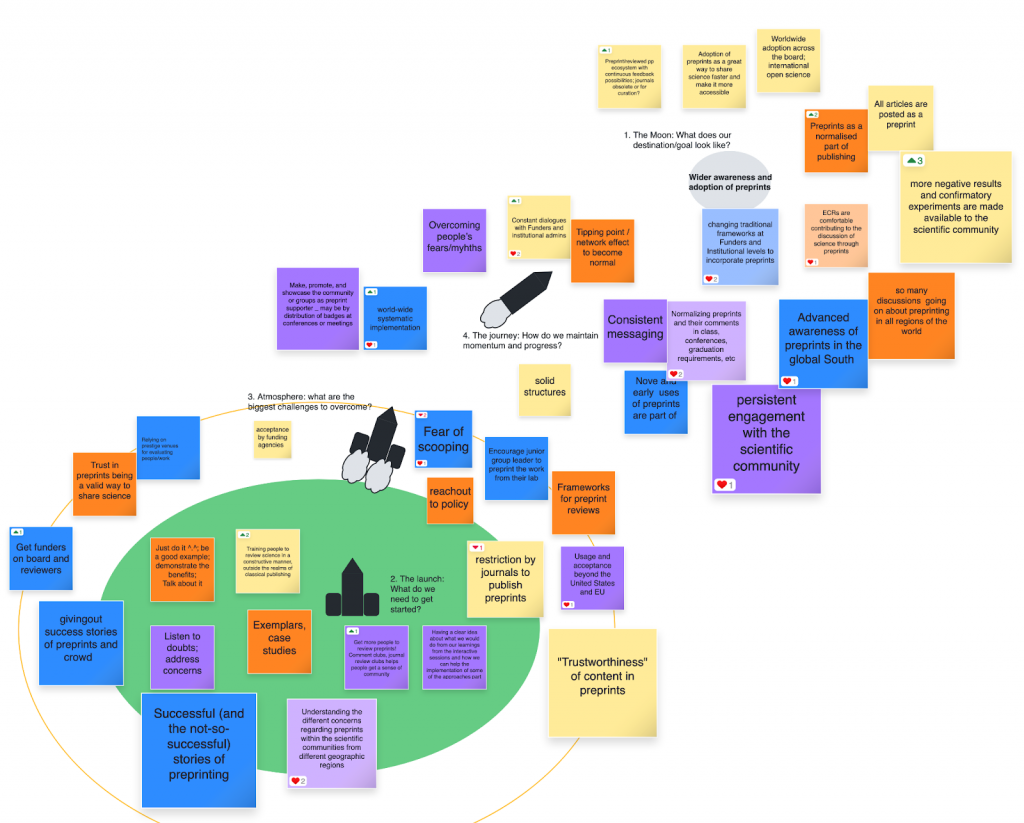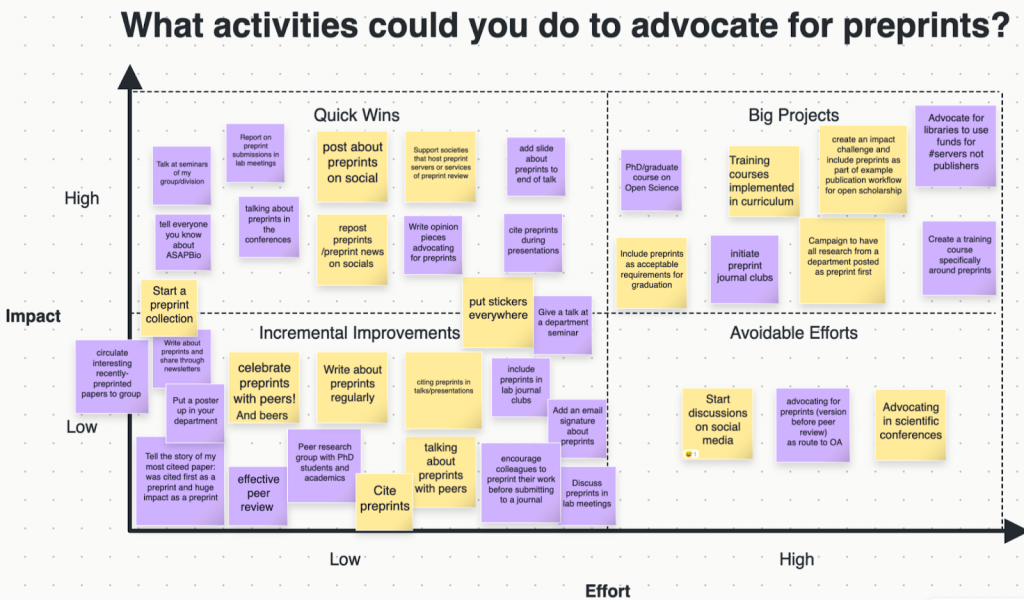As this year’s Fellows program comes to an end we wanted to reflect back on the past 8 months. The 2023 Fellows have been involved in a variety of projects from crowd preprint review to exploring the perceptions of preprints from researchers across Africa. Throughout the program, we have been utilising a fun, if underused, feature on zoom – whiteboards. This feature allows all participants to collaboratively write on a virtual whiteboard which can be set up with various layouts to guide conversations. Participants can then also vote on other comments and suggestions. Not only is this a great feature to break the (potential) monotony of zoom calls but these whiteboards capture important information that can be built upon and shared after the call.
One of the first whiteboard exercises we performed with the 2023 Fellows was a “moonshot” activity. This scenario is similar to the sailboat retrospective but invokes imagery related to landing on the moon. Participants start by outlining what success looks like (i.e. landing on the moon) and then works back from what activities are needed to start (launch the rocket), what challenges need overcoming (breaking through the atmosphere & gravity of Earth) and then what is required to maintain momentum (the journey to the moon). In response to “what does the wider awareness and adoption of preprints look like”, our Fellows had a number of inspiring views. The one with the most up-votes was that ‘more negative results and confirmatory experiments are made available to the scientific community’ and that ‘preprints are a normalised part of publishing’. Fellows also highlighted global adoption and awareness as being part of this ideal success. So how do we get started on this path? The Fellows had a variety of opinions but these were largely based around training, listening, understanding and ‘just doing’. These are activities that ASAPbio is heavily involved in already! The biggest challenges to overcome will resonate with the wider community. These included ‘fear of scooping’, ‘trust’, ‘recognition of preprints’, ‘relying on prestige signals’ and securing support from funders and institutions. To maintain momentum, the Fellows had numerous suggestions. Some of the most up-voted were the normalisation of preprints, persistence and constant dialogue with stakeholders.

We also asked Fellows for their opinions on the good and bad of the current preprint landscape. Of the “great things”, it was clear that the progress and growth of preprints over the past 5 years has been successful. However, the increasing number of preprint servers was one of three things listed as both great and not-so-great, along with new opportunities and the challenging of existing money-making formats. In the “not-so-great” column, were the ‘lingering myths around preprints’ and the large amount of work remaining outside of the EU and US and the wider geographic inequality. The remaining lack of recognition of preprints was also highlighted as a persistent problem. Fellows also pointed out that preprints are essentially still the same format as journal articles and that this is a big remaining issue.

Our Fellows also listed efforts that they could do to advance preprint adoption – a whiteboard that you are all very welcome to steal ideas from! These efforts were broken down into “quick wins”, “big projects”, “‘incremental improvements” and “avoidable efforts”. For the quick wins, Fellows listed activities that coalesced around communicating with others including on social media, at conferences, by writing opinion pieces or by giving talks. The incremental improvements included using preprints in lab meetings, citing preprints and celebrating posting preprints. One that we could all do was to add an email signature about the benefits of preprints – a suggestion is included at the bottom of this post. Big projects included training courses based around preprints, preprint journal clubs (see our crowd preprint review!) and to advocate different funding models such as libraries providing funds for preprint servers not publishers.

Key themes from across the interactive activities
Across the whiteboard activities, there were a number of key themes that emerged:
- There has been amazing progress in the uptake and adoption of preprints
- There are large geographical disparities between uptake and awareness of preprints
- There are persistent myths and misconceptions of preprints that hamper adoption
- There is still lots of work to be done in relation to recognition for preprints from funders, policy makers and institutions
Generally, there’s lots of successes with the awareness and adoption of preprints. There have been leaps forward from journals, funders and (some) institutions in their recognition of preprints. However, this progress is heavily skewed towards the EU and USA. Additionally, institution recognition still requires more effort to be widespread. As far as we have come – bioRxiv celebrated their 10 year birthday in November – preprints do only represent ~8-10% of the biomedical literature and so there is much more exciting work to be done!
Suggested email signature addition:
Preprints help you get more citations, speed up dissemination of science and are beneficial for ECR’s. Post, read and review preprints. Learn more here.







